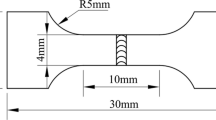Abstract
Austenitic stainless steel 316L is welded by laser beam with T-joint in this paper. Microstructures of fusion zone consist of a large amount of austenite and a small amount of ferrite; heat-affected zone (HAZ) width is about 10 μm. The fine-equiaxed dendrites existing as network morphology locate at the center of fusion zone, and columnar structures are near HAZ. Microhardness at the top of the cross-section of welded joints is higher than that at the bottom, and the hardness of the second pass is higher than that of the first pass. The numerical result of maximum deformation (2.67 mm) keeps a good line with that of the experiment result (2.52 mm). The maximum value of the longitudinal compressive stress is 306 MPa, while the residual stress of the first pass is slightly released during the second pass welding process. The transverse residual stress along line 1 always presents a compressive state. At the 3.5 mm position far from the bead center, a large fluctuation of angular deformation and longitudinal residual stress are induced by the high-temperature gradient. Maximum values of angular deformation and equivalent residual stress for the whole sample are 1.37 mm and 452.3 MPa, and these both locate at the end-start zone of the welding path.
Similar content being viewed by others
References
Baddoo NR (2008) Stainless steel in construction: a review of research, applications, challenges and opportunities. J Constr Steel Res 64:1199–1206
Gardner L (2005) The use of stainless steel in structures. Prog Struct Engng Mater 7:45–55
Kumar S, Shahi AS (2014) On the influence of welding stainless steel on microstructural development and mechanical performance. Mater Manuf Process 29:894–902
Tseng KH, Hsu CY (2011) Performance of activated TIG process in austenitic stainless steel welds. J Mater Process Technol 211:503–512
Cho HH, Hong ST, Roh JH, Choi HS, Kang SH, Steel RJ, Han HN (2013) Three-dimensional numerical and experimental investigation on friction stir welding processes of ferritic stainless steel. Acta Mater 612:649–2661
Bang HS, Bang HS, Jeon GH, Oh IH, Ro CS (2012) Gas tungsten arc welding assisted hybrid friction stir welding of dissimilar materials Al6061-T6 aluminum alloy and STS304 stainless steel. Mater Des 37:48–55
Mukherjee M, Saha S, Pal TK, Kanjilal P (2015) Influence of modes of metal transfer on grain structure and direction of grain growth in low nickel austenitic stainless steel weld metals. Mater Charact 102:9–18
Adak M, Soares CG (2014) Effects of different restraints on the weld-induced residual deformations and stresses in a steel plate. Int J Adv Manuf Technol 71:699–710
Ravisankar A, Velaga SK, Rajput G, Venugopal S (2014) Influence of welding speed and power on residual stress during gas tungsten arc welding (GTAW) of thin sections with constant heat input: a study using numerical simulation and experimental validation. J Manuf Process 16:200–211
Elmesalamy A, Francis JA, Li L (2014) A comparison of residual stresses in multi pass narrow gap laser welds and gas-tung sten arc welds in AISI 316L stainless steel. Int J Pressure Vessels Pip 113:49–59
Ye YH, Cai JP, Jiang XH, Dai DP, Deng DA (2015) Influence of groove type on welding-induced residual stress, deformation and width of sensitization region in a SUS304 steel butt welded joint. Adv Eng Softw 86:39–48
Alipooramirabad H, Paradowska A, Ghomashchi R, Kotousov A, Reid M (2015) Quantification of residual stresses in multi-pass welds using neutron diffraction. J Mater Process Technol 226:40–49
Erdem M, Altug M, Karabulut M (2016) Investigation of mechanical, microstructural, and machining properties of AISI 420 martensitic stainless steel welded by laser welding. Int J Adv Manuf Technol 85:481–492
Alizadeh-Sh M, Marashi SPH, Pouranvari M (2014) Resistance spot welding of AISI 430 ferritic stainless steel: phase transformations and mechanical properties. Mater Des 56:258–263
Devendranath Ramkumar K, Thiruvengatam G, Sudharsan SP, Mishra D, Arivazhagan N, Sridhar R (2014) Characterization of weld strength and impact toughness in the multi-pass welding of super-duplex stainless steel UNS 32750. Mater Des 60:125–135
Lakshminarayanan AK, Balasubramanian V (2012) Assessment of fatigue life and crack growth resistance of friction stir welded AISI 409M ferritic stainless steel joints. Mater Sci Eng A-Struct Mater Prop Microstruct Process 539:143–153
Feng YQ, Luo Z, Liu ZM, Li Y, Luo YC, Huang YX (2015) Keyhole gas tungsten arc welding of AISI 316L stainless steel. Mater Des 85:24–31
Lee HT, Jeng SL, Yen CH, Kuo TY (2004) Dissimilar welding of nickel-based alloy 690 to SUS 304L with Ti addition. J Nucl Mater 335:59–69
Janaki Rama GD, Venugopal Reddy A, Prasad Rao K, Reddy GM, Sarin Sundar JK (2005) Microstructure and tensile properties of Inconel 718 pulsed Nd-YAG laser welds. J Mater Process Technol 167:73–82
Cui CY, Cui XG, Ren XD, Liu TT, Hu JD, Wang YM (2013) Microstructure and microhardness of fiber laser butt welded joint of stainless steel plates. Mater Des 49:761–765
Goldak J, Chakravarti A, Bibby M (1984) A new finite element model for welding heat sources. Metall Trans B 15:299–305
Rong YM, Zhang GJ, Huang Y (2016) Study on deformation and residual stress of laser welding 316L T-joint using 3D/shell finite element analysis and experiment verification. Int J Adv Manuf Technol. doi:10.1007/s00170-016-9246-4
Brickstad B, Josefson BL (1998) A parametric study of residual stresses in multi-pass butt-welded stainless steel pipes. Int J Pressure Vessels Pip 75:11–25
Benedetti M, Fontanari V, Santus C (2013) Crack growth resistance of MAG butt-welded joints of S355JR construction steel. Eng Fract Mech 108:305–315
Rong YM, Zhou Q, Huang Y, Chang Y, Zhang GJ, Shao XY (2016) Multi-objective optimization of laser brazing with the crimping joint using ANN and NSGA-II. Int J Adv Manuf Technol 85:1239–1247
Author information
Authors and Affiliations
Corresponding author
Rights and permissions
About this article
Cite this article
Rong, Y., Huang, Y., Zhang, G. et al. Laser beam welding of 316L T-joint: microstructure, microhardness, distortion, and residual stress. Int J Adv Manuf Technol 90, 2263–2270 (2017). https://doi.org/10.1007/s00170-016-9501-8
Received:
Accepted:
Published:
Issue Date:
DOI: https://doi.org/10.1007/s00170-016-9501-8



